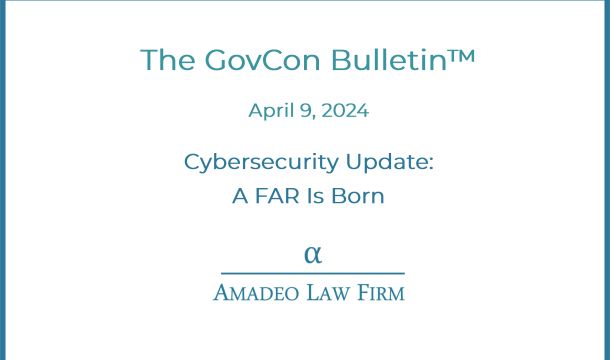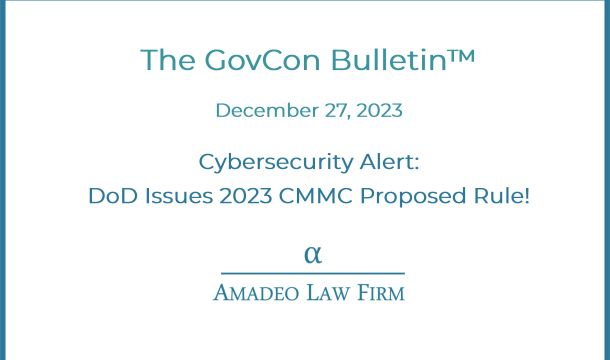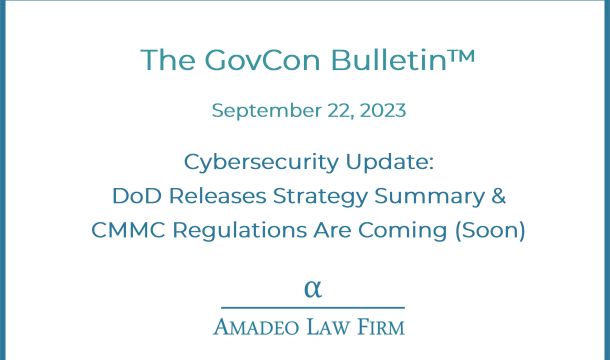Final Rule Amends SBA Regulations On Mentor-Protégé Programs, Joint Ventures and The 8(a) BD Program, Part 2: Joint Ventures
August 17, 2016
Part 2 of Our Summary of SBA's Changes To Regulations On Mentor-Protégé Programs, Joint Ventures and 8(a) BD Program
A few weeks ago, on July 25, 2016, the U.S. Small Business Administration (SBA) issued a final rule (the "Final Rule") amending SBA regulations to implement provisions of the Small Business Jobs Act of 2010 and the National Defense Authorization Act of 2013 (NDAA 2013). The Final Rule, which becomes effective on August 24, 2016 and can be found here, did three things. First, it established a government-wide mentor-protégé program for all small businesses and made clarifications and conforming changes to the mentor-protégé program under the 8(a) Business Development (“8(a) BD”) program. Second, it made several changes to the rules applicable to joint ventures. Lastly, it made clarifications to the rules applicable to the 8(a) BD program.
In a prior edition of The GovCon Bulletin,™ which you can read here, we summarized the Final Rule's changes to the SBA's mentor-protégé programs.
In this edition of The GovCon Bulletin,™ we summarize the Final Rule's changes to the SBA's regulations on joint ventures.
Mark Amadeo
In the Final Rule, the SBA made several changes to the rules that apply to joint ventures between small businesses, joint ventures between SDVOSB’s (contained in § 125.15(b) and are now found in § 125.18(b), joint ventures between HUBZone small businesses (contained in § 126.616), and joint ventures between WOSB’s and EDWOSB’s (found in § 127.506). These changes, described below, were made in order to more closely align the requirements of the above-mentioned types of small business joint ventures not only to each other, but also to the requirements for 8(a) BD joint ventures.
Joint Venture Formation
The Final Rule adopts the language in the proposed rule clarifying that a joint venture under the SBA’s rules may be a formal or informal partnership or exist as a separate limited liability company or other separate legal entity. Regardless of form, however, under the Final Rule, the joint venture must be reduced to a written agreement.
In addition, the Final Rule adopts the proposed language that allows a separate legal entity joint venture to have its own separate employees to perform administrative functions, but not to have its own separate employees to perform contracts awarded to the joint venture. This requirement that joint ventures remain unpopulated for all but administrative functions is a departure from the current rules.
Access To Joint Venture Files and Records
In the proposed rule, the SBA required joint venture partners to allow SBA's authorized representatives to access files and inspect and copy records and documents when necessary. In response to comments requesting that access should be limited to documents and records relating to the joint venture and not to unrelated documents of the joint venture partners themselves, the Final Rule amends the provisions related to the various types of joint ventures (§§ 124.513(i), 125.8(h), 125.18(b)(8), 126.616(h), and 127.506(i)) to clarify that SBA's access would be related to files, records and documents of the joint venture.
Place of Performance
In October 2013, the SBA issued a final rule that essentially overruled a GAO decision that limited small business acquisitions to those that were conducted only within the United States and outlying areas. That SBA rule, in § 125.2(a) and (c), recognizes that small business contracting can be used "regardless of the place of performance.” The Final Rule now adds similar language to §§ 124.501, 125.22(b), 126.600, and 127.500, thus specifically authorizing contracting in the 8(a) BD, SDVO, HUBZone and WOSB programs regardless of the place of performance, including overseas.
HUBZone Joint Ventures
Under existing regulations a HUBZone joint venture must be comprised of HUBZone small businesses only. However, under the Final Rule, the SBA permits joint ventures comprised of a HUBZone protégé firm and its mentor to compete for HUBZone contracts, regardless of whether the mentor is itself a HUBZone qualified small business.
Joint Venture Certifications and Performance of Work Reports
The Final Rule adopts the proposed rule’s requirement that all partners to a joint venture agreement that perform under contracts set aside for SDVOSB, WOSB, HUBZone small businesses, or other small businesses certify to the contracting officer and the SBA prior to performing under the contract that they will perform in compliance with the joint venture regulations and with the joint venture agreement. The joint venture partners are also required to report to the contracting officer and to SBA how they are meeting or have met the applicable performance of work requirements for each SDVOSB, HUBZone, WOSB or small business set-aside contract they perform as a joint venture.
Tracking Joint Venture Awards
In the proposed rules, the SBA announced that it was considering different methods of tracking awards to the joint ventures permitted by SBA's regulations. The possible approaches included: Requiring joint ventures to include in their names “small business joint venture,” and, if a mentor-protégé joint venture, to include in their names “mentor-protégé small business joint venture;” requiring contracting officers to identify awards as going to small business joint ventures or to mentor-protégé small business joint ventures; requiring small businesses to amend their SAM entries to specify that they have formed a joint venture; requiring each joint venture to get a separate DUNS number; or a combination of all of these actions. The Final Rule requires joint ventures to be separately identified in SAM so that awards to joint ventures can be properly accounted for. A joint venture must be identified as a joint venture in SAM, with a separate DUNS number and CAGE number than those of the individual parties to the joint venture. In addition, the Entity Type in SAM must be identified as a joint venture, and the individual joint venture partners should also be listed.
Protesting the Size of 8(a) Joint Ventures
The Final Rule amends § 124.513 to clarify that interested parties, including unsuccessful offerors, may protest the size of an SBA-approved 8(a) joint venture that is the apparent successful offeror for a competitive 8(a) set-aside contract. This change is in response to a rule expressed in Size Appeal of Goel Services, Inc. and Grunley/Goel Joint Venture D LLC, SBA No. SIZ-5320 (2012), which concluded that the size of an SBA-approved 8(a) joint venture could not be protested because SBA had, in effect, determined the joint venture to qualify as small when it approved the joint venture pursuant to § 124.513(e). The SBA rejects this ruling and has taken the position that only its Office of Government Contracting may issue formal size determinations.
A few commenters to the proposed rule also sought clarification of SBA's regulations regarding when SBA will determine the eligibility of an 8(a) joint venture. The SBA's regulations provide that SBA approval of an 8(a) joint venture must occur prior to the award of an 8(a) contract. The SBA has taken the position that a district office need not make this determination as part of the offer and acceptance process and that it has flexibility to determine the eligibility of a particular 8(a) joint venture depending upon its workload. As long as that determination occurs any time prior to award, SBA has complied with the regulatory requirement.
Agency Consideration of the Past Performance and Capabilities of Team Members
Under the Final Rule, an agency must consider the past performance of the members of a joint venture when considering the past performance of an entity submitting an offer as a joint venture. The SBA originally proposed this only for 8(a) joint ventures (§ 124.513(f)) and small business joint ventures (§ 125.8(e)). The Final Rule, jowever, also adds similar language to SDVOSB joint ventures (§ 125.18(b)(5)), HUBZone joint ventures (§ 126.616(f)), and WOSB joint ventures (§ 127.506(f)).



